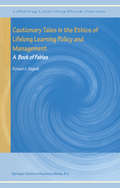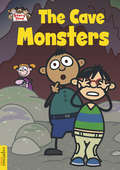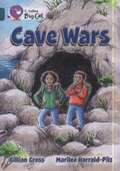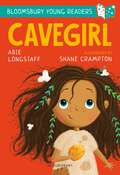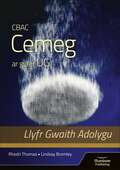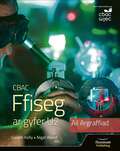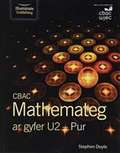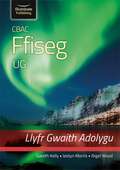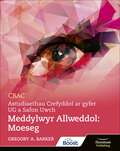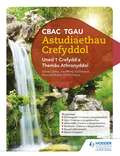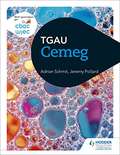- Table View
- List View
The Causes of Exclusion: Home, School and the Development of Young Criminals
by Cedric CullingfordThis report synthesizes two approaches to a topical problem: the concern with social deviancy and crime which focuses on failure; and research on educational development which focuses on success. The book explores how environmental experiences (including parenting and bullying) play a role.
The Causes Of Exclusion (PDF): Home, School And The Development Of Young Criminals
by Cedric CullingfordThis report synthesizes two approaches to a topical problem: the concern with social deviancy and crime which focuses on failure; and research on educational development which focuses on success. The book explores how environmental experiences (including parenting and bullying) play a role.
The Causes of High and Low Reading Achievement
by Ronald P. CarverThis book describes all of the important factors that cause some students to have low reading achievement and others to have high reading achievement. It concentrates on the main factors that influence how much a student gains in reading achievement during a year of school, or a calendar year. An attempt is made to answer the following questions: what can educators do to increase reading achievement, and what is beyond their influence? The author is directly concerned with achievement associated with normal or typical reading. The focus of the book is on things teachers can do during an entire school year that are likely to improve the reading level and reading rate of students, which in turn, will increase their reading achievement. This effort to specify the most important causes of high and low reading achievement represents an integration of two disciplines of scientific psychology--experimental psychology and psychometrics. A glossary at the end of the book contains definitions of terms and concepts. Helpful appendices explain rauding theory, the three laws of rauding theory, and the equations that can be used to predict the accuracy of reading comprehension, provide conversions among units of rauding rate, and list the numbered equations presented in the book.
The Causes of High and Low Reading Achievement
by Ronald P. CarverThis book describes all of the important factors that cause some students to have low reading achievement and others to have high reading achievement. It concentrates on the main factors that influence how much a student gains in reading achievement during a year of school, or a calendar year. An attempt is made to answer the following questions: what can educators do to increase reading achievement, and what is beyond their influence? The author is directly concerned with achievement associated with normal or typical reading. The focus of the book is on things teachers can do during an entire school year that are likely to improve the reading level and reading rate of students, which in turn, will increase their reading achievement. This effort to specify the most important causes of high and low reading achievement represents an integration of two disciplines of scientific psychology--experimental psychology and psychometrics. A glossary at the end of the book contains definitions of terms and concepts. Helpful appendices explain rauding theory, the three laws of rauding theory, and the equations that can be used to predict the accuracy of reading comprehension, provide conversions among units of rauding rate, and list the numbered equations presented in the book.
Cautionary Tales: Strategy Lessons From Struggling Colleges
by Alice W. BrownScarcely a week goes by without a headline about the unsustainability of higher education as we know it, under threat from new models, for-profits, or online education. Most threatened are small liberal arts colleges – with commentators predicting the demise of colleges with fewer than 1,000, or even 1,500 students. Are these trends inevitable, or can they be overcome?Through a unique case study approach to examining and analyzing colleges that have struggled, Alice Brown reveals the steps that can lead to a sustainable operation and, when closure is inevitable, the steps to do so with orderliness and dignity. Rather than expounding on trends, or management theory and prescriptions, Brown focuses on narrative examples of survival and closure, recounted by real people in actual colleges, and reports the lessons they learned. Here are examples of strategies involving mergers, partnerships, or “going it alone”, and their outcomes, that illustrate principles that can serve as guides for fragile colleges struggling to address their social and economic challenges.Added to Brown’s six carefully researched and extended case studies, her own insights and analyses of decisions made and actions taken, this book offers guidance by seasoned scholars and administrators on issues as varied as leadership, the roles of the president, governing boards, faculty and staff, in articulating and implementing mission and strategies for survival, and on the changing landscape of higher education. The references to the literature on college survival strategies constitute an education in themselves.While this book is of immediate practical value for trustees and leaders of small colleges as they look toward and plan for the future and for anyone aspiring to an administrative positions in higher education, the examples constitute a microcosm of the interplay between the external constituencies, governance structures and internal forces that sustain or undermine institutional health, and which are hard to observe clearly in larger, more decentralized environments.
Cautionary Tales: Strategy Lessons From Struggling Colleges
by Alice W. BrownScarcely a week goes by without a headline about the unsustainability of higher education as we know it, under threat from new models, for-profits, or online education. Most threatened are small liberal arts colleges – with commentators predicting the demise of colleges with fewer than 1,000, or even 1,500 students. Are these trends inevitable, or can they be overcome?Through a unique case study approach to examining and analyzing colleges that have struggled, Alice Brown reveals the steps that can lead to a sustainable operation and, when closure is inevitable, the steps to do so with orderliness and dignity. Rather than expounding on trends, or management theory and prescriptions, Brown focuses on narrative examples of survival and closure, recounted by real people in actual colleges, and reports the lessons they learned. Here are examples of strategies involving mergers, partnerships, or “going it alone”, and their outcomes, that illustrate principles that can serve as guides for fragile colleges struggling to address their social and economic challenges.Added to Brown’s six carefully researched and extended case studies, her own insights and analyses of decisions made and actions taken, this book offers guidance by seasoned scholars and administrators on issues as varied as leadership, the roles of the president, governing boards, faculty and staff, in articulating and implementing mission and strategies for survival, and on the changing landscape of higher education. The references to the literature on college survival strategies constitute an education in themselves.While this book is of immediate practical value for trustees and leaders of small colleges as they look toward and plan for the future and for anyone aspiring to an administrative positions in higher education, the examples constitute a microcosm of the interplay between the external constituencies, governance structures and internal forces that sustain or undermine institutional health, and which are hard to observe clearly in larger, more decentralized environments.
Cautionary Tales in the Ethics of Lifelong Learning Policy and Management: A Book of Fables (Lifelong Learning Book Series #1)
by Richard G. BagnallThis work is concerned with appraising the contemporary ethical impact of lifelong learning ideology and advocacy on education, through focusing on trends in educational policy and management that flow from the ideology. It has its origins in the author's concern that many of those trends are being defmed and promoted, or opposed, without an adequate understanding of their ethical dimensions. The 21 trends examined in this work are seen as defming important dimensions of the quite radical changes in educational policy and management that are flowing from the practical realisation of lifelong learning ideology and advocacy. In here evaluating those trends from an ethical perspective, the thesis is developed that they lead inevitably to distinctive ethical dilemmas or tensions in the lived experience of educational participants. The dilemmas, though, are not seen as realities that can intelligently be either avoided or resolved. They are, rather, inescapable features of the trends, although they and the experience of them may be managed intelligently to a greater or lesser extent. This analysis is premised on the belief that an understanding of the dilemmas may be of practical value in assisting educators, and policy makers and managers, to live and work more intelligently with them and to better manage the educational changes that are defmed by the trends. It may thereby contribute to moderating the excesses, sillinesses, and inanities so often evident in the directing and managing of refonns associated with the trends and to reduce the anguish and pain associated with them.
Cave Art: Band 05/green (Collins Big Cat Phonics For Letters And Sounds Ser.)
by Rob Alcraft Collins Big CatCollins Big Cat Phonics for Letters and Sounds features exciting fiction and non-fiction decodable readers to enthuse and inspire children. They are fully aligned to Letters and Sounds Phases 1–6 and contain notes in the back. The Handbooks provide support in demonstration and modelling, monitoring comprehension and expanding vocabulary. Green/Band 5 books offer early readers patterned language and varied characters. The focus sounds in this book are: Pages 22 and 23 allow children to re-visit the content of the book, supporting comprehension skills, vocabulary development and recall. Reading notes within the book provide practical support for reading Big Cat Phonics for Letters and Sounds with children, including a list of all the sounds and words that the book will cover.
The Cave Monsters: The Cave Monsters (Espresso: Story Time #4)
by Sue GravesPolly, Kim and Ash are at the beach with the dogs, Scully and Scrap. They decide to explore a cave, but there are MONSTERS inside!This series featuring the popular characters from Espresso Education includes fun stories in under 200 words for children building their reading confidence.
Cave Wars (PDF)
by Gillian Cross Marilee Harrald-PilzRuby and Tom love playing in the caves; that's before the Gang arrive. But they're not about to give them up without a fight. When a simple plan goes wrong, it looks like they might need the Gang after all. Find out what happens in this exciting adventure story by Carnegie winner, Gillian Cross.
Cavegirl: A Bloomsbury Young Reader (Bloomsbury Young Readers)
by Abie LongstaffAggie needs to get a present for her Mum's birthday and Gron has a piece of amber that would be perfect! But getting the amber may be harder than Aggie thought, especially when a wild boar appears...This prehistoric adventure from well-loved author Abie Longstaff is perfect for children who are learning to read by themselves are for Key Stage 1. It features engaging illustrations from Shane Crampton and fun characters young readers will find hard to resist.Bloomsbury Young Readers are the perfect way to get children reading, with book-banded stories by brilliant authors like Julia Donaldson. They are packed with gorgeous colour illustrations and include inside cover notes to help adults reading with children, as well as ideas for activities related to the stories.Book Band: TurquoiseIdeal for ages 6+
Cavegirl: A Bloomsbury Young Reader (Bloomsbury Young Readers)
by Abie LongstaffAggie needs to get a present for her Mum's birthday and Gron has a piece of amber that would be perfect! But getting the amber may be harder than Aggie thought, especially when a wild boar appears...This prehistoric adventure from well-loved author Abie Longstaff is perfect for children who are learning to read by themselves are for Key Stage 1. It features engaging illustrations from Shane Crampton and fun characters young readers will find hard to resist.Bloomsbury Young Readers are the perfect way to get children reading, with book-banded stories by brilliant authors like Julia Donaldson. They are packed with gorgeous colour illustrations and include inside cover notes to help adults reading with children, as well as ideas for activities related to the stories.Book Band: TurquoiseIdeal for ages 6+
CBAC Cemeg UG Llyfr – Gwaith Adolygu (WJEC Chemistry for AS Level – Revision Workbook)
by Lindsay Bromley Rhodri ThomasCBAC Ffiseg ar gyfer U2 – Argraffiad Diwygiedig (WJEC Physics for A2 Student Book – Revised Edition)
by Gareth Kelly Nigel WoodCbac Gofal, Chwarae, Dysgu, A Datblygiad Plant: Lefel 3
by Lianne D. HaymerMae’r llyfr hwn wedi’i ysgrifennu’n arbennig ar gyfer cwrs Lefel 3 Gofal, Chwarae, Dysgu, a Datblygiad Plant. Mae’r gwerslyfr hwn yn addas i ddysgwyr o bob gallu, ac mae’n rhoi sylw i’r wybodaeth a’r sgiliau y bydd eu hangen ar ddysgwyr wrth iddynt ddilyn y cwrs.
Cbac Gofal, Chwarae, Dysgu, A Datblygiad Plant: Lefel 3
by Lianne D. HaymerMae’r llyfr hwn wedi’i ysgrifennu’n arbennig ar gyfer cwrs Lefel 3 Gofal, Chwarae, Dysgu, a Datblygiad Plant. Mae’r gwerslyfr hwn yn addas i ddysgwyr o bob gallu, ac mae’n rhoi sylw i’r wybodaeth a’r sgiliau y bydd eu hangen ar ddysgwyr wrth iddynt ddilyn y cwrs.
Cbac Gofal, Chwarae, Dysgu, A Datblygiad Plant: Lefel 2
by Clare ParsonsMae’r llyfr hwn wedi’i ysgrifennu’n arbennig ar gyfer cwrs Lefel 2 Gofal, Chwarae, Dysgu, a Datblygiad Plant. Mae’r gwerslyfr hwn yn addas i ddysgwyr o bob gallu, ac mae’n rhoi sylw i’r wybodaeth a’r sgiliau y bydd eu hangen ar ddysgwyr wrth iddynt ddilyn y cwrs.
Cbac Gofal, Chwarae, Dysgu, A Datblygiad Plant: Lefel 2
by Clare ParsonsMae’r llyfr hwn wedi’i ysgrifennu’n arbennig ar gyfer cwrs Lefel 2 Gofal, Chwarae, Dysgu, a Datblygiad Plant. Mae’r gwerslyfr hwn yn addas i ddysgwyr o bob gallu, ac mae’n rhoi sylw i’r wybodaeth a’r sgiliau y bydd eu hangen ar ddysgwyr wrth iddynt ddilyn y cwrs.
CBAC Lefel 1/2 Dyfarniad Galwedigaethol Celfyddydau Perfformio Cydymaith Cwrs
by Carys Edwards Marvin Thomas Sophie Angell-JonesMae’r llyfr hwn wedi’i ysgrifennu’n benodol ar gyfer cwrs Dyfarniad Galwedigaethol Lefel 1/2 Celfyddydau Perfformio (Dyfarniad Technegol). Mae’r llyfr wedi cael ei ysgrifennu er mwyn galluogi dysgwyr o alluoedd gwahanol i ddatblygu’r sgiliau a’r wybodaeth sydd eu hangen i wneud cynnydd a chwblhau’r cymhwyster yn llwyddiannus.
CBAC Mathemateg ar gyfer U2 - Pur (PDF)
by Stephen DoyleWritten by bestselling author Stephen Doyle, the new WJEC Mathematics for A2 Level - Pure Student Book will support and motivate students through the course and help them thoroughly prepare for their exams.
CBAC Religious Studies for A Level & AS Key Thinkers: Ethics
by Gregory BarkerWelsh Language Edition. An essential companion to help students master one of the most important areas of their Religious Studies course in Ethics: knowing the key thinkers.- Provides an overview of each thinker's life and their ideas, with key dates, social context and why they are important.- Helps students understand the thinkers' main arguments and how they justified their approach to ethics, allowing students to evaluate the theories them for themselves.- Exam guidance section in each chapter provides a focus for revision and includes advice on how different types of questions could be tackled.- Encourages students to explore each area of scholarly knowledge required by the specification, from grasping key ideas to knowing how to best criticise a thinker's approach.- Puts ideas and theories into contemporary contexts to help students build their evaluation skills.- Timeline displaying an overview of the key dates for each thinker in relation to world events.- Key thinkers covered include Thomas Aquinas, John Stuart Mill, Thomas Hobbes and Jeremy Bentham.
CBAC TGAU Astudiaethau Crefyddol Uned 1 Crefydd a Themâu Athronyddol (WJEC GCSE Religious Studies: Unit 1 Religion and Philosophical Themes Welsh-language edition)
by Joy White Chris Owens Ed Pawson Amanda Ridley Steve ClarkeWelsh language edition. For the new Welsh specification for first teaching 2017. Stretch and challenge your students to achieve their full potential with learning materials that guide them through the new Unit 1 content and assessment requirements; developed by subject experts with examining experience and the leading Religious Studies publisher.- Enables you to teach philosophical themes confidently with clear explanations of Christian, Muslim, Jewish and Buddhist beliefs and practices.- Motivates students to build and cement their knowledge and skills using a range of imaginative, innovative activities that support learning and revision.- Prepares students for examination with exam focus sections at the end of each unit that provide guidance on how to tackle questions.- Helps students of all abilities fulfil their potential and increase their understanding through clear, detailed explanations of the key content and concepts.WJEC GCSE Religious StudiesUnit 1 Religious Responses to Philosophical ThemesCovering:- Christianity: Beliefs and teachings- Islam: Beliefs and teachings- Judaism: Beliefs and teachings- Buddhism: Beliefs and teachings- Life and Death- Good and Evil
CBAC TGAU Busnes (WJEC GCSE Business Welsh-language edition) (Cbac Wjec) (PDF)
by Malcolm Surridge Andrew GillespieEnsure that every student can fulfil their potential with this tailor-made Student Book for the 2017 specification; our bestselling Business authors develop knowledge and skills through clear explanations, real-life examples and assessment practice questions. - Builds understanding of business concepts through accessible explanations, supported by definitions of key terms and tips that highlight important points and common misconceptions - Enables students to apply their knowledge to real business examples, issues and contexts in the 'Business insight' feature - Develops investigative, analytical and evaluation skills through multiple choice, short answer and case study/data response questions, sample answers and commentary - Encourages students to track their progress using learning outcomes, end-of-chapter summaries and knowledge-check questions - Helps students practise and improve their quantitative skills via the 'Maths moment' feature - Stretches students with questions that test their ability to make an informed judgement This is a Welsh language edition
CBAC TGAU Cemeg (WJEC GCSE Chemistry Welsh-language edition)
by Adrian Schmit Jeremy PollardExam Board: WJECLevel: GCSESubject: ChemistryFirst Teaching: September 2016First Exam: June 2018Welsh edition.Expand and challenge your students' knowledge and understanding of Chemistry with this textbook that guides students through each topic within the new curriculum; produced by a trusted author team and the established WJEC GCSE Science publisher. - Test understanding and reinforce learning with differentiated Test Yourself questions, Discussion points, exam-style questions and useful chapter summaries.- Provide support for all required practicals along with extra tasks for broader learning. - Support the mathematical and Working scientifically requirements of the new specification with opportunities to develop these skills throughout. - Supports the separate sciene Chemisrty and is also suitable to support the WJEC GCSE Science (Double Award) qualification.




